Riding on the highways of big data, we will always think about: What is leading us forward and where will we lead? Come and listen to the vision of Dr. Ahmad Bahai, Chief Technology Officer of Texas Instruments : TI's disruptive technology is a picture of a better future for work and life.
When I stepped on the accelerator pedal in an electric car, the speed could rise from 0 to nearly 100 kilometers in 3 seconds - I really enjoy the process. Just as I drive galloping on the fast lane of the expressway, a new generation of technology will carry us on the fast lane of the big data highway.
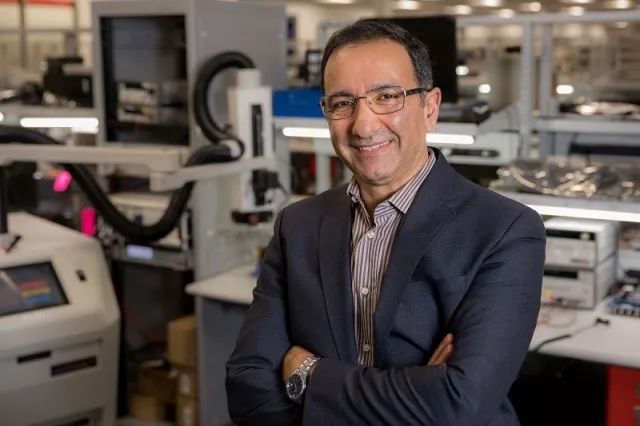
TI Chief Technology Officer Dr. Ahmad Bahai
Imagine that new technologies will affect our future work and life:
â— The auto assembly line will reconfigure the cooperative robots to assemble different types of vehicles. This will greatly increase productivity and bring about competitive advantage while reducing costs. Today, resetting one such factory may take several years.
â— Machine vision technology will enable people to see clearly even when driving in nighttime, foggy and dusty environments.
â— The size of the charger will be reduced to the size of the credit card, and you can easily plug it into your pocket.
â— People will welcome new foods - made with 3D printers, such as delicious pasta. You only need to put the ingredients in the printer. It will automatically download recipes on the Internet. When you arrive home after work, you can enjoy hot food.
As these disruptive technologies continue to be used in industrial, automotive and other industries, as well as the continuous development of new markets, analog and embedded processing semiconductor technologies will lay the foundation for future production of innovative, energy-efficient, high-performance, and cost-effective products.
Let us learn more about some innovative technologies and the realities that may be realized in the future:
No need to run out of battery power to get power from electric vehicles
The advantages of gallium nitride (GaN) and silicon carbide (SiC) in high-voltage applications have been widely discussed in the power supply industry, and reliability issues are the last barrier to their widespread adoption. Now that we have overcome this problem, wait for this exciting new opportunity to apply in the automotive, industrial, medical, and consumer electronics markets.
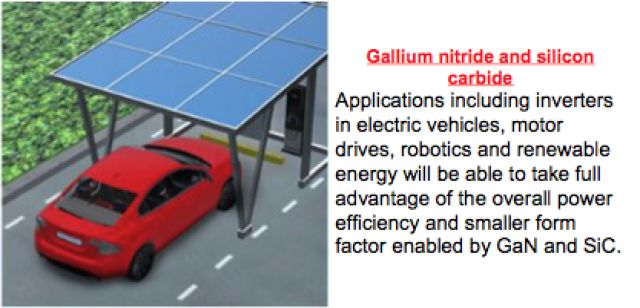
The advantages of GaN and SiC in high voltage applications
The high energy efficiency and small size characteristics of these devices will be fully utilized in applications such as electric vehicle inverters, motor drives, robots and renewable energy sources. E.g:
â— The inverter connected to the renewable energy grid will be smaller and the power will be higher.
◠Increasing power management efficiency will significantly increase the mileage of electric vehicles and provide torque for the quick start of electric vehicles without depleting their power reserves—this is equivalent to the energy consumption of gas vehicles. Battery technology is continuously improving, and the cost can reach about 100 US dollars per kilowatt-hour, which is expected to become a turning point for large-scale use of electric vehicles.

Integrated clock: 1 second error every 10 years

We live in the era of big data, and the 5G era is coming. In 2018, data transmitted over wired and wireless networks is expected to reach 2 zettabytes, or 2 trillion GB (gigabytes). Gigabit sampled data converters, high-speed interfaces, and high-performance radios will be our high-speed development path into the technology.
These systems require extremely accurate, high-performance clocks for reference. A fully integrated clock with a 1 second error every 10 years will provide unprecedented performance support for big data.
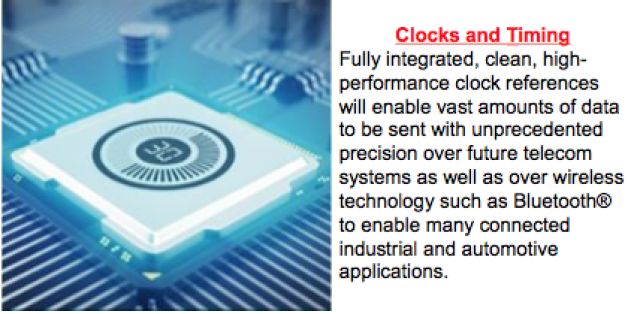
TI MEMS Clock Reference Innovation Design
Moreover, as the clock signal runs on the circuit board and the system, the noise or jitter generated by it also needs to be cleared. Crystal-clock based reference designs have been used in the industry for decades, and the MEMS clock reference innovation design will provide higher performance, lower jitter, and more integrated solutions.
Through thick fog and dust
Machine vision is one of the fastest growing technologies in the industrial and automotive markets. With the development of smart cars, collaborative robots, and industrial metrology, the convergence of cameras, radar, lasers, and ultrasound technology is particularly important.
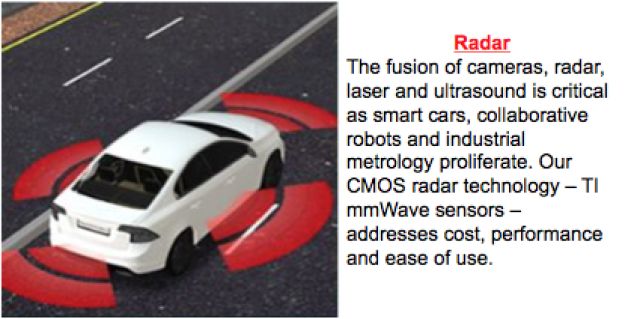
TI's CMOS Radar Technology - TI Millimeter Wave Sensors
Of course, radar is nothing new. Over the years it has been widely deployed in the time-of-flight technology of automatic cruise control systems. However, integrating the entire radio front-end, digital signal processing, and antennas onto a single chip has been a daunting engineering challenge that remains true today.
The CMOS radar technology from Texas Instruments - Texas Instruments millimeter wave sensor, can solve the problem of cost, performance and difficulty of use. This will enhance many new applications and increase the resolution of the vision system:
â— New radar technology can penetrate fog and dust to identify objects and even identify dangerous ice areas on the road;
â— The hospital can use radar to remotely monitor the patient's heartbeat through clothes;
â— The precise operation provided by radar technology enables autonomous robots to quickly and efficiently move materials, equipment and boxes on the factory floor or in warehouses.
The innovation company will continue to use this technology to develop new applications and open new doors for automotive autopilot, robotics and smart buildings.

Protect sensors and actuators from damage

Recently, industrial plants are accelerating their progress by using smart and linked machines to increase efficiency, safety and productivity. In a standard modern factory, there are thousands of sensors and network devices that can connect a large number of motors, sensors, and actuators, and can safely and reliably exchange data and power between different modules and subsystems.
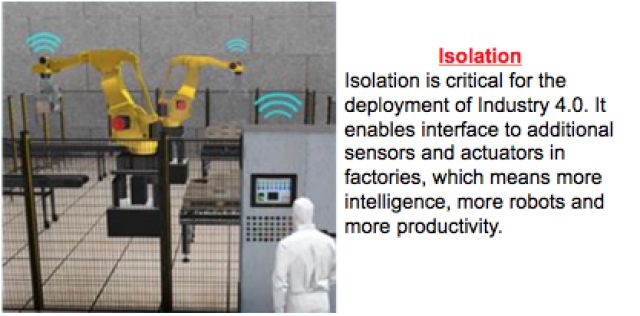
TI isolation technology
Isolation Techniques—In order to protect the controller against transients and interferences, changes in technology have become critical in the deployment of Industry 4.0. Isolation technology allows companies to deploy more sensors and actuators in the factory, which means that the factory is more intelligent, can drive more robots and achieve higher productivity.
The transmission of gigabit data and power through highly integrated enhanced isolation barriers requires innovations in packaging, materials, and integrated circuit design. The application of powerful digital isolators has accelerated the development of these technologies in industrial and automotive applications.
Technology affects all aspects of our daily lives, and the pace of change will only become faster and faster. In addition to the gravity sensing function, my electric car will now automatically open the garage door, enter the lane, and heat or cool to the right temperature. It will notify me when it is ready, and then it will automatically open the door when it sees me.
These TI technologies - GaN and silicon carbide, clocks and timing, radar and isolation - will make high efficiency, power management, collaboration, connectivity and intelligence a reality.
A tablet computer is an electronic device that integrates mobile commerce, mobile communication and mobile entertainment, with a touch recognition LCD screen, handwriting recognition and wireless network communication functions. At present, the tablet computer has become the most popular electronic product.
1.In appearance, the tablet computer looks like a large-screen mobile phone, or more like a separate LCD screen.
2.In terms of hardware configuration, a tablet computer has all the hardware devices of a traditional computer, and has its own unique operating system, compatible with a variety of applications, and has a complete set of computer functions.
3.Tablet PC is a kind of miniaturized computer. Compared with traditional desktop computers, tablet computers are mobile and flexible. Compared with notebook computers, tablet computers are more compact and more portable.
4.Tablet PC is a digital notebook with digital ink function. In daily use, you can use the tablet computer like an ordinary notebook, take notes anytime and anywhere, and leave your own notes in electronic texts and documents.
Tablet Pc Pad,Mobile Tablet,Scratch Pad Tablet Pc,Tablet Pc,Tablets & Presentation Equipment,Educational Tablet
Jingjiang Gisen Technology Co.,Ltd , https://www.jsgisengroup.com
